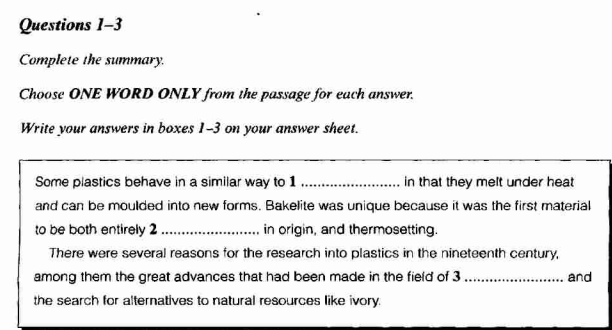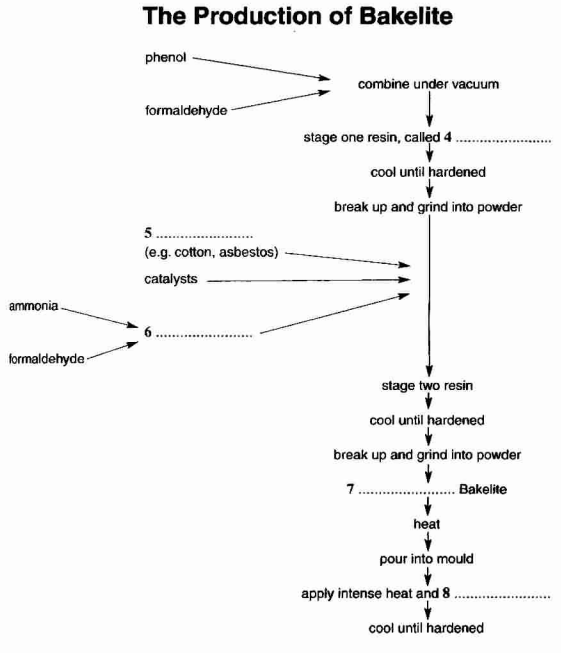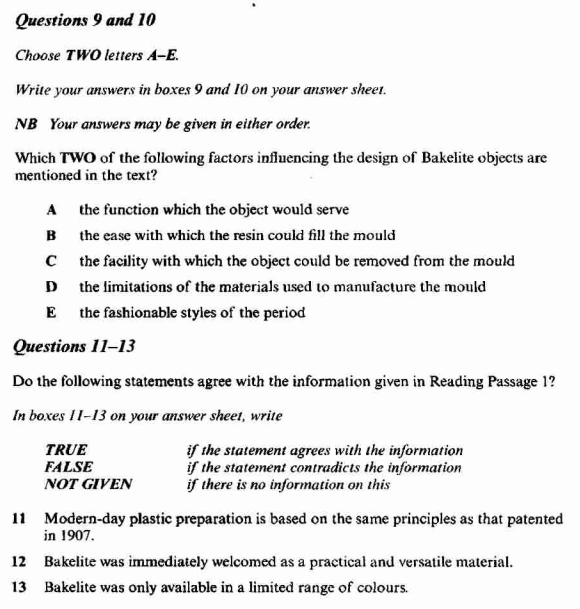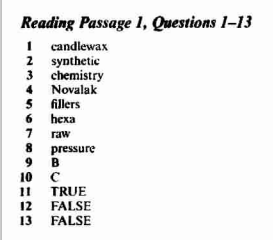剑桥雅思5:Test2雅思阅读PASSAGE 1真题+答案+解析
发布时间:2020-09-23 关键词:剑桥雅思5:Test2雅思阅读PASSAGE 1真题+答案+解析为了帮助大家在雅思考试中取得的成绩,下面新航道小编为大家整理出关于剑桥雅思5:Test2雅思阅读PASSAGE 1真题+答案+解析,大家可以多加练习。
READING
READING PASSAGE 1
You should spend about 20 minutes on Questions 1-l3, which are based on Reading Passage 1below.
BAKELITE
The birth of modern plastics
In 1907, Leo Hendrick Baekeland, a Belgian scientist working in New York, discovered andpatented a revolutionary new synthetic material. His invention, which he named 'Bakelite",was of enormous technological importance, and effectively launched the modern plasticsindustry.
The term 'plastic" comes from the Greek plassein, meaning 'to mould'. Some plastics arederived from natural sources, some are semi-synthetic (the result of chemical action on anatural substance), and some are entirely synthetic, that is, chemically engineered from theconstituents of coal or oil. Some are "thermoplastic", which means that, like candlewax, theymelt when heated and can then be reshaped. Others are 'thermosetting': like eggs, they
cannot revert to their original viscous state, and their shape is thus fixed for ever. Bakelite hadthe distinction of being the first totall synthetic thermosetting plastic.
The history of today's plastics begins with the discovery of a series of semi- synthetic
thermoplastic materials in the mid-nineteenth century. The impetus behind the developmentof these early plastics was generated by a number of factors - immense technological
progress in the domain of chemistry, coupled with wider cultural changes, and the pragmaticneed to find acceptable substitutes for dwindling supplies of 'luxury' materials such as
tortoiseshell and ivory.
Baekeland's interest in plastics began in 1 885 when, as a young chemistry student in
Belgium, he embarked on research into phenolic resins, the group of sticky substances
produced when phenol (carbolic acid) combines with an aldehyde (a volatile fluid similar toalcohol). He soon abandoned the subject, however, only returning to it some years later. By1905 he was a wealthy New Yorker, having recently made his fortune with the invention of anew photographic paper. While Baekeland had been busily amassing dollars, some advanceshad been made in the development of plastics. The years 1899 and 1900 had seen the
patenting of the first semi-synthetic thermosetting material that could be manufactured onan industrial scale. In purely scientific terms, Baekeland's major contribution to the field is notso much the actual discovery of the material to which he gave his name, but rather the
method by which a reaction between phenol and formaldehyde could be controlled, thus making possible its preparation on a commercial basis. On 13 July 1907, Baekeland took cuthis famous patent describing this preparation, the essential features of which are still in usetoday,
The original patent outlined a three-stage process, in which phenol and formaldehyde
(from wood or coal) were initially combined under vacuum inside a large egg-shaped kettle.The result was a resin known as Novalak, which became soluble and malleable when heated.The resin was allowed to cool in shallow trays until it hardened, and then broken up and
ground into powder. Other substances were then introduced: including fllers, such as
woodflour, asbestos or cotton, which increase strength and moisture resistance, catalysts(substances to speed up the reaction between two chemicals without joining to either) andhexa, a compound of ammonia and formaldehyde which supplied the additional
formaldehyde necessary to form a thermosetting resin. This resin was then left to cool andharden, and ground up a second time. The resulting granular powder was raw Bakelite, readyto be made into a vast range of manufactured objects. In the last stage, the heated Bakelitewas poured into a hollow mould of the required shape and subjected to extreme heat andpressure, thereby 'setting' its form for life.
The design of Bakelite objects, everything from earrings to television sets, was governed to alarge extent by the technical requirements of the moulding process. The object could not bedesigned so that it was locked into the mould and therefore difficult to extract. A commangeneral rule was that objects should taper towards the deepest part of the mould, and ifnecessary the product was moulded in separate pieces. Moulds had to be carefully designedso that the molten Bakelite would flow evenly and completely into the mouid. Sharp cornersproved impractical and were thus avoided, giving rise to the smooth, 'streamlined' style
popular in the 1930s. The thickness of the walls of the mould was also crucial: thick walstook longer to cool and harden, a factor which had to be considered by the designer in orderto make the most efficient use of machines.
Baekeland's invention, although treated with disdain in its early years, went on to enjoy anunparalleled popularity which lasted throughout the first half of the twentieth century. Itbecame the wonder product of the new world of industrial expansion - 'the material of athousand uses. Being both non-porous and heat-resistant, Bakelite kitchen goods were
promoted as being germ-free and steriisable. Electrical manufacturers seized on its insulatingproperties, and consumers everywhere relished its dazzling array of shades, delighted thatthey were now, at last, no longer restricted to the wood tones and drab browns of the pre-plastic era. It then fell from favour again during the 1950s, and was despised and destroyedin vast quantities. Recently, however, it has been experiencing something of a renaissance,with renewed demand for original Bakelite objects in the collectors' marketplace, and
museums, societies and dedicated individuals once again appreciating the style and originalityof this innovative material.
接下来,我们先来看下阅读题目:




看完阅读题目有没有自己先做下题呢?小编为大家整理了阅读题目以及答案解析,一起来看看吧!

Question 1
答案: candlewax
关键词:similar/melt under heat
定位原文: 第2段倒数第2句“...like candlewax, they melt when heated...”
解题思路:只要能够在第二段中找到定位词melt和heated,很快就能够找到similar的同义词like。因此答案应该选择candlewax。
Question 2
答案: synthetic
关键词: bakelite/both...and.../themosetting
定位原文: 第2段最后1句“Bakelite had the distinction of being…”
解题思路: distinction和first对应题目中的unique,而thermoseting一词前面只有synthetic这个词可以选择,即使不认识,也可以填上去。
Question 3
答案: chemistry
关键词:the nineteenth century/advances/field/ivory
定位原文: 第3段第2句“The impetus…”
解题思路: 选用nineteenth century和ivory两个特殊词找到答案定位,然后再仔细寻找great advances的对应词immense technological progress,随后马上可以看到field的对应词domain。因此这道题目应该填chemistry。
Question 4
答案: Novalak
关键词: avoid overcrowded centre
定位原文: D段最后1句“Instead…”
解题思路: instead是一个转折连接词,后面的观点与前者刚好相反。上一句说 pushing everyone into the city centre was not the best approach,刚好证明我们应该避免造成一个过度拥挤的市中心。
Question 5
答案: fillers
关键词: cotton / asbestos / catalysts
定位原文: 第5段第4句“Other…”
解题思路: 此处需要注意答案并不是woodflour,因为文中说 fillers such as woodflour, asbestos or cotton,后三者是作者举出的filler的具体例子,故不选。
Question 6
答案: hexa
关键词:ammonia/formaldehyde
定位原文: 第5段第4句的后半句“hexa, a compound…”
解题思路: 此题目位置稍有颠倒,但是只要明白compound是混合物的意思就不难得到答案是hexa。
Question 7
答案: raw
关键词: resin/cool/harden/break up/powder/bakelite
定位原文: 第5段第5句“This resin…”
解题思路: 第五段先找到cool和harden,很快看到Bakelite,前面的词是raw。
Question 8
答案: pressure
关键词:mould /intense heat /cool
定位原文: 第5段最后1句“In the last stage…”
解题思路: extreme 和 intense 属于同义表达,空处和intense heat形成并列关系,答案很容易得出是pressure。
Question 9 & Question 10
答案:B C
关键词: design/Bakelite
定位原文: 第6段第2句“The object…”第6段第4句“Moulds had to be…”
解题思路: 第2句对应C选项,could not locked into 和题目的remove from 属于同义表达;第4句对应B选项,fill 和 flow completely into 也属于同义表达。
Question 11
答案: TRUE
关键词:based on / the same
定位原文: 第1段第2句和第4段最后1句
解题思路: 文中launch 一词实际上指的是1907年获得专利的技术开启了现代塑料工业的大门。所以答案应该是TRUE。这一点在最后一段中也能得到印证。
Question 12
答案: FALSE
关键词:welcome
定位原文: 第7段第1句和倒数第2句
解题思路: 文中明确提到在其刚刚诞生的时候,酚醛塑料颇为大众所不屑,并不是立即就受到欢迎。下面的文章又提到 it then fell from favour again during the 1950s. immediately 一词过于,一般在题目中出现该词选FALSE。
Question 13
答案:FALSE
关键词:colours
定位原文: 第7段第4句“...delighted that they were now, at last, no longer restricted to the wood tones and drab browns of the preplastic era.”
解题思路: 这句话告诉我们在塑料发展的初级阶段,人们只能买到木色和棕色的产品,但是随着技术的进步,人们不再限于这两种单调的颜色了。only 一词过于,一般在题目中出现了该词选FALSE。




